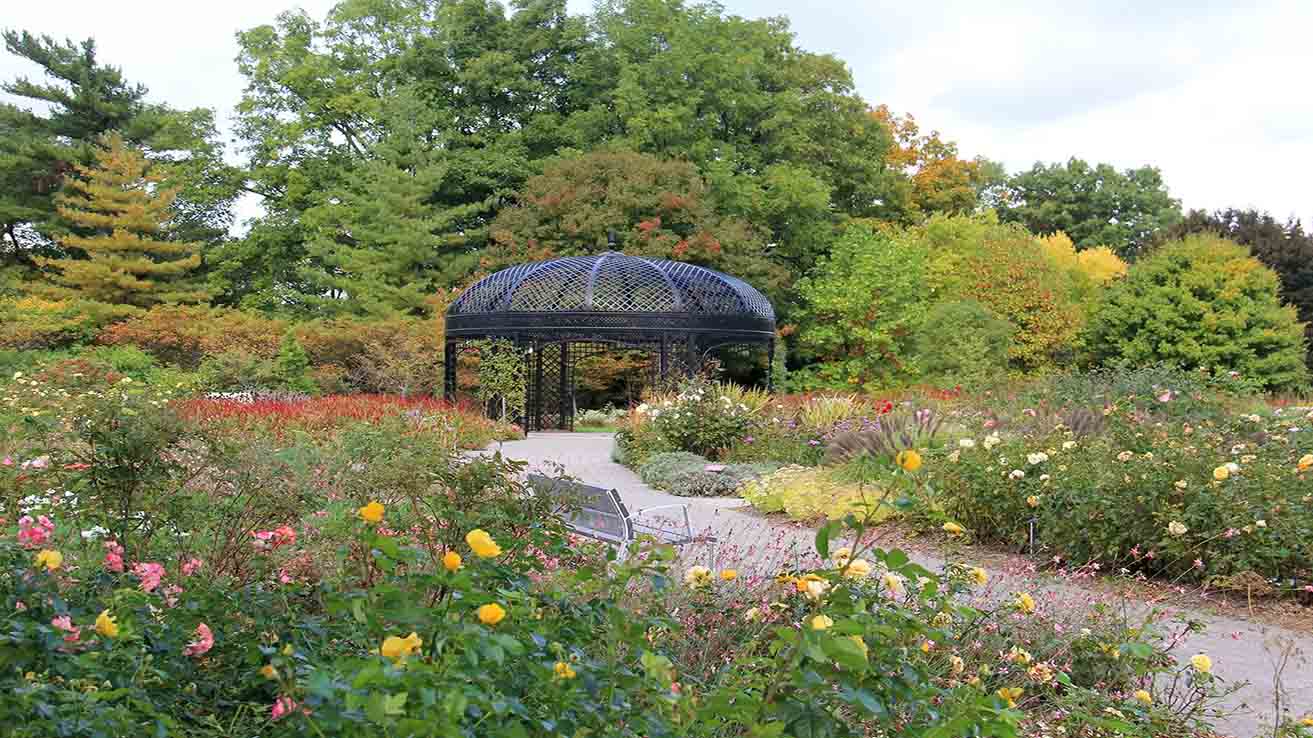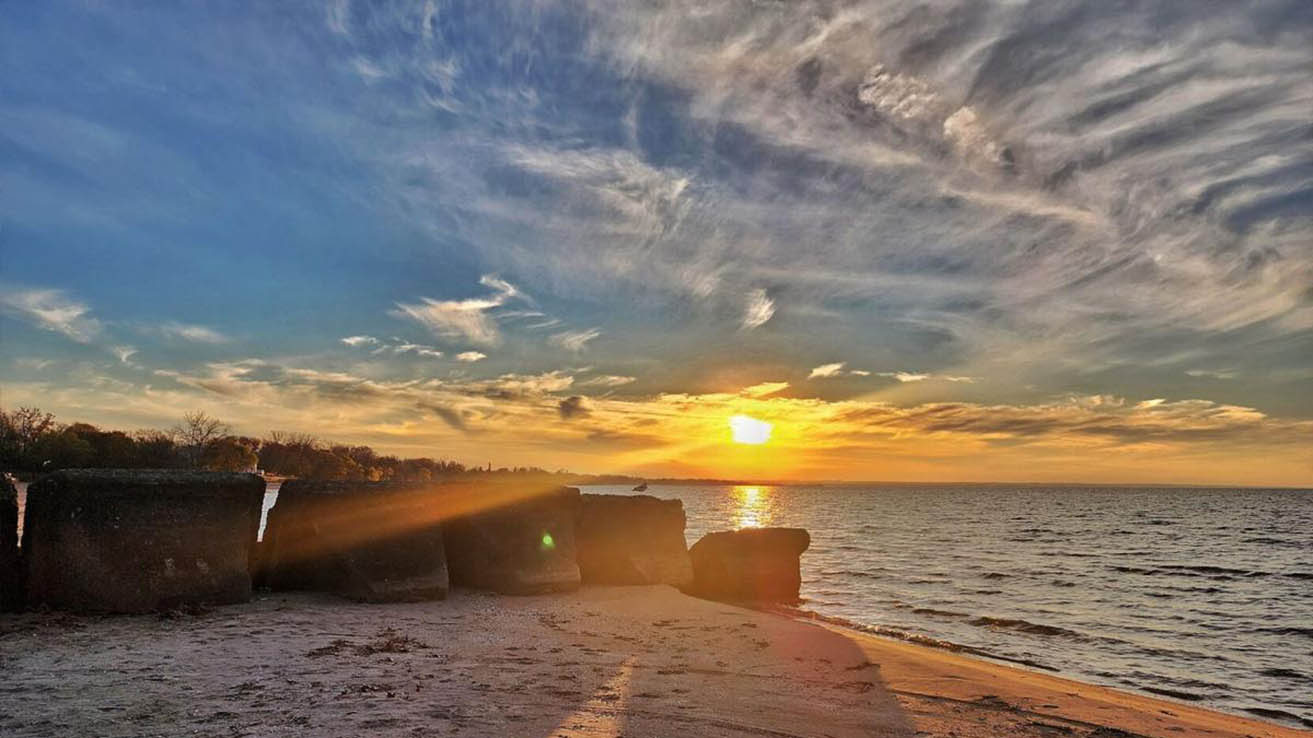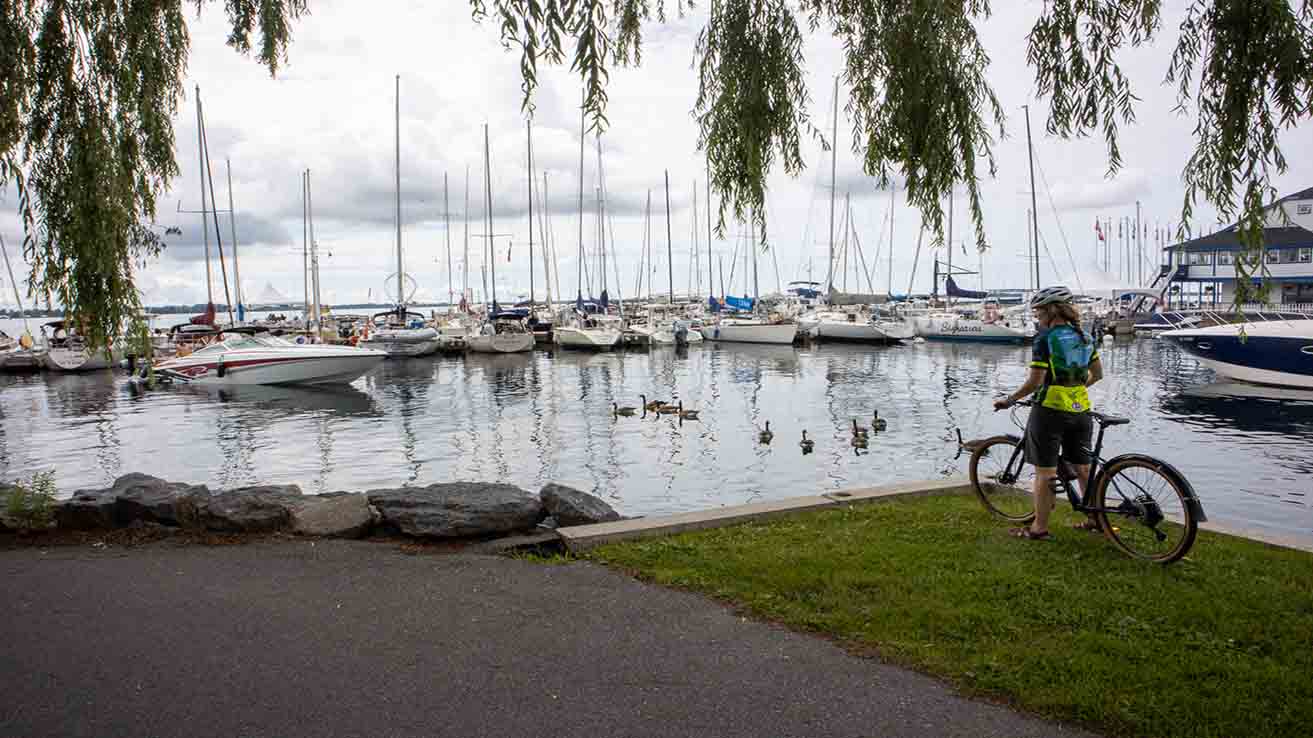When September arrives in Ontario, the air begins to shift. Mornings carry a crisp edge, afternoons are golden with slanted sunlight, and the trees hint at the riot of colors they will soon unleash. On one of these luminous September mornings, I found myself on a train heading toward Hamilton, eager to spend the day at the Royal Botanical Gardens (RBG)—Canada’s largest botanical garden, a place often called the green jewel of the region.
I had read countless descriptions of its sprawling landscapes, themed gardens, and natural trails. But no guidebook prepared me for the intimate, almost spiritual connection I would feel walking among its thousands of plant species, the delicate hummingbirds darting through flowerbeds, and the way the gardens open into wilderness trails that feel far removed from the hum of city life.
Arriving at the Royal Botanical Gardens
The RBG is located at 680 Plains Road West, Burlington, Ontario, just on the edge of Hamilton. Getting there was simple: I booked my train ticket to Hamilton through VIA Rail, and then caught a short rideshare to the entrance. For those flying in, Toronto Pearson Airport is just under an hour away; I usually use Google Flights or Skyscanner to find affordable tickets and then compare options through Expedia Canada for accommodation bundles.
Tickets for the RBG can be purchased on their official website (rbg.ca), but platforms like Viator or GetYourGuide also offer guided experiences if you want a structured tour. Admission was around \$20 CAD for adults when I visited, with discounts for seniors, students, and children. Considering how vast the grounds are—2,700 acres of gardens and nature sanctuaries—the fee felt like a small investment for a full day’s exploration.
Hendrie Park: The Heart of the Gardens
My walk began at Hendrie Park, one of the most popular and accessible parts of the RBG. The moment I entered, I was greeted by the scent of late-summer roses still clinging to their last blooms. September is a magical in-between month here—many summer flowers remain vibrant, while autumn perennials begin to take over, creating a patchwork of seasonal colors.
The Rose Garden stopped me in my tracks. Hundreds of varieties lined the paths, their colors ranging from the deepest crimson to the softest blush. Bees moved lazily from petal to petal. I sat on a wooden bench under a trellis and allowed myself to simply breathe, letting the mixture of floral fragrance and crisp air wash over me.
Walking further, I discovered the Global Garden, a collection that celebrates biodiversity from around the world. There were Mediterranean herbs, desert succulents, and tropical plants carefully curated to show the diversity of ecosystems. Informational plaques explained each plant’s origin, and I found myself jotting down notes for my own small balcony garden at home.
Tips: Hendrie Park is stroller- and wheelchair-friendly, with paved paths. If you’re planning lunch, the RBG Centre café nearby offers fresh sandwiches, soups, and baked goods—though I recommend checking OpenTable ahead of time to see if there are reservations available during busy weekends.
The Rock Garden: Where History Meets Design
Next, I headed to the David Braley & Nancy Gordon Rock Garden, located at 1185 York Boulevard. This garden has been part of the RBG since the 1930s, but it underwent a major renovation a few years ago. What struck me immediately was the interplay between stone and flora—sloping terraces, winding staircases, and carefully chosen plants cascading over rock ledges.
In September, the Rock Garden radiated late-summer warmth: golden black-eyed Susans, fiery red sedums, and ornamental grasses swaying in the breeze. The water features here—gentle streams and reflective pools—added a calming soundtrack to my walk.
I lingered by a small pond, where dragonflies skimmed the surface and children tossed pebbles into the water. The space felt both meticulously designed and naturally wild, a blend that left me in awe.
Cost note: Entrance to the Rock Garden is included with the general RBG ticket, which makes it a must-see stop. For photographers, sunrise and sunset tours can sometimes be booked through GetYourGuide, offering special access for golden-hour shots.
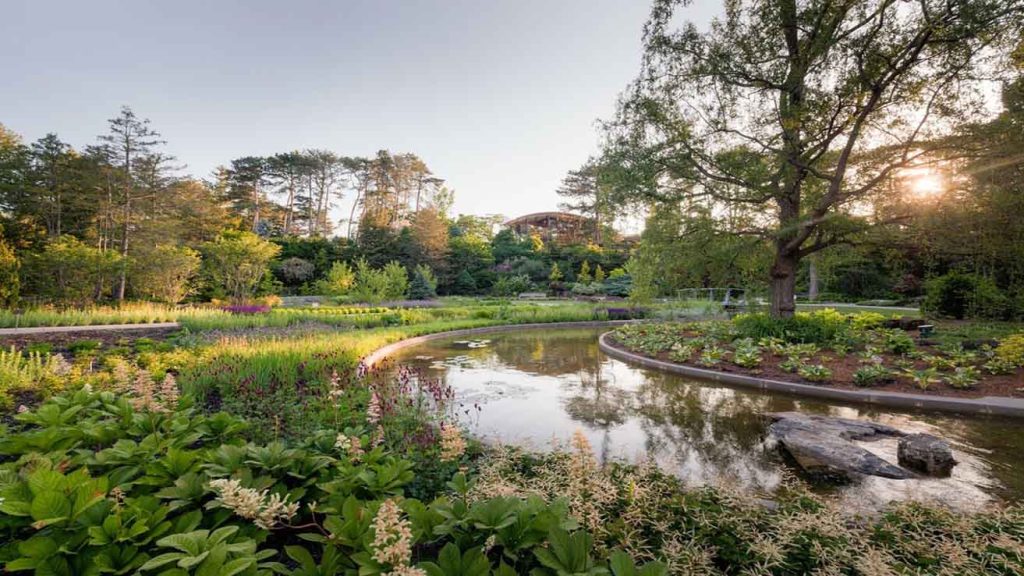
Laking Garden: A Sanctuary for Perennials
A short walk (or shuttle ride) brought me to Laking Garden, located at 1260 Spring Gardens Road. This space is entirely dedicated to perennials, making September an especially rewarding time to visit. Many late-season blooms—asters, goldenrods, and chrysanthemums—were at their peak.
I walked the long, terraced beds, admiring the clever planting combinations that balanced color, texture, and height. What struck me most was how educational this garden felt. Each section included signs explaining plant care, making it a living classroom for gardeners.
Nearby, I discovered a quiet bench overlooking the Desjardins Canal, where ducks and geese floated lazily. It was one of those perfect, reflective pauses where the noise of everyday life fell away completely.
Advice: Bring water and snacks here; there are fewer amenities compared to Hendrie Park. For families, this is a less crowded area, ideal for slower, contemplative strolls.
Natural Trails: From Gardens to Wilderness
The RBG isn’t just about curated flowerbeds—it’s also home to extensive nature sanctuaries. Over 27 kilometers of trails weave through marshes, forests, and meadows, connecting the gardens to surrounding landscapes.
I followed the RBG Escarpment Trails, which link to the famous Bruce Trail, Canada’s oldest and longest marked footpath. September is the perfect month for these hikes: the heat of summer has faded, but the leaves haven’t fully dropped, giving trails a mosaic of green with hints of orange and red.
Along the Marsh Walk at Cootes Paradise Sanctuary, I spotted great blue herons standing motionless in the shallow waters, waiting for fish. The boardwalk offered panoramic views of the wetlands, and interpretive signs explained the RBG’s conservation efforts to restore habitats for native wildlife.
Note on costs: Access to most trails is included with the general admission ticket. If you’re planning a full-day hike, wear sturdy shoes and pack layers, as the weather can change quickly in September.
Nearby Attractions Within Walking Distance
One of the joys of visiting the RBG is discovering what lies just beyond its gates. With comfortable shoes, several nearby attractions are easily reachable on foot.
- Hamilton Harbourfront (Bayfront Park, 200 Harbour Front Drive): About a 30-minute walk east from the Rock Garden, this park offers sweeping views of the harbor. Joggers, cyclists, and families gather here, and I treated myself to a gelato from a nearby café.
- Dundurn Castle (610 York Boulevard): Just a 20-minute stroll from the Rock Garden, this 19th-century neoclassical mansion offers a peek into Hamilton’s past. Tickets are around \$14 CAD, bookable through the City of Hamilton website or platforms like TripAdvisor Experiences.
- Royal Hamilton Yacht Club (555 Bay Street North): If you continue toward the waterfront, the marina area is lively with sailing activity in September. Even as a casual visitor, watching the boats return at sunset felt cinematic.
Where to Stay Near the RBG
After a long day of walking, I was glad I had booked a hotel nearby. Hamilton offers a range of options—from budget to boutique. For this trip, I reserved a room through Booking.com, which allowed me to compare prices and read reviews.
- For convenience, Admiral Inn Hamilton (149 Dundurn St N) is less than 10 minutes from Dundurn Castle. Rooms average around \$150 CAD per night in September.
- For something more upscale, The Barracks Inn (425 Wilson St E, Ancaster) offers boutique charm and is about a 15-minute drive from the RBG.
When booking, I often check Hotels.com for rewards points, or Airbnb Canada for unique stays like historic homes or loft apartments.
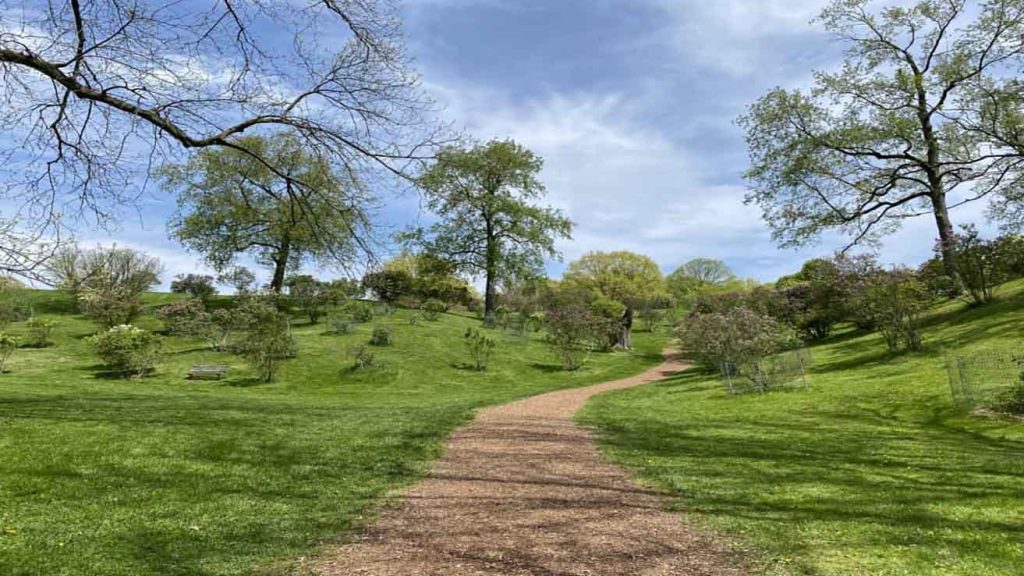
Dining After the Gardens
Exploring gardens works up an appetite, and fortunately, Hamilton has plenty of dining options nearby.
- Earth to Table: Bread Bar (258 Locke St S): Known for wood-fired pizzas and fresh, locally sourced ingredients.
- The Burnt Tongue (10 Cannon St E): A cozy spot for soups and sandwiches, perfect after a cool September walk.
- Aberdeen Tavern (432 Aberdeen Ave): An elegant restaurant housed in a former bank, offering upscale comfort food.
I booked my table at Aberdeen Tavern through OpenTable, which allowed me to snag a Saturday night reservation during a busy weekend. For quick snacks or coffee, the cafés near Locke Street are unbeatable.
Practical Tips for Visiting the RBG in September
- Weather: September can swing from warm afternoons (20–25°C) to cool evenings (10–15°C). Dress in layers.
- Tickets: Buy online in advance at rbg.ca or through platforms like Viator for guided tours.
- Footwear: Comfortable walking shoes are essential—expect to cover several kilometers.
- Timing: Arrive early in the day to enjoy quieter paths. Weekends can get busy, especially during special events.
- Accessibility: Hendrie Park and the Rock Garden are stroller- and wheelchair-friendly, but some trails are rugged.
- Photography: Morning and late afternoon light are best for capturing the gardens.
Reflections as I Left
As the sun began to set, casting long shadows across the Rock Garden’s stone terraces, I felt a quiet gratitude. The Royal Botanical Gardens isn’t just a place to admire flowers—it’s a living, breathing reminder of how landscapes can connect us to something larger than ourselves. September, with its gentle transitions, heightened that feeling of impermanence and beauty.
I left with tired legs, a camera full of photos, and a sense of calm that only nature can provide. More than just a tourist attraction, the RBG is an invitation to slow down, to notice, and to carry a piece of serenity back into everyday life.
